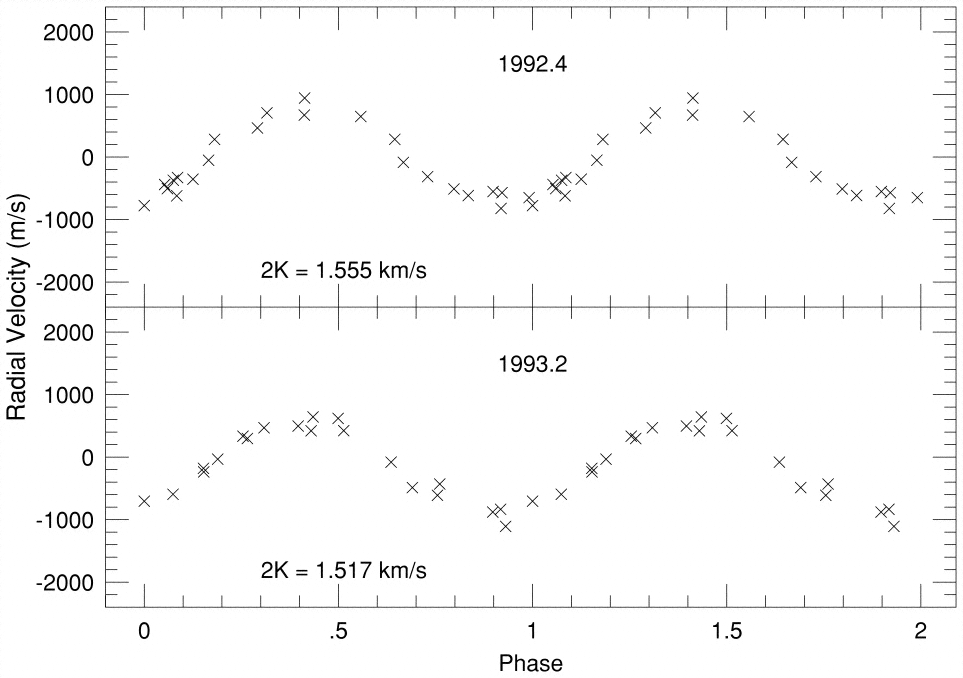In part 1, I described my involvement in the MARVELS project and the discovery of a brown-dwarf-mass object orbiting the star now known as MARVELS-1. I had been concerned about very large radial velocity residuals to our orbital fit, and was stunned to discover they were consistent with an inner planet orbiting the star in a 3:1 commensurability with the BD.
In part 2, I explained our attempt to characterize the system, and our general unease with the system: the resonance appeared to be perfect, there were not many stable dynamical solutions, the star had two AO companions, and I kept getting lots of hints that this sort of thing might come from contamination. But the spectrum was clean of contaminants, and the photometry was rock-steady. We finally decided to get some Keck data to settle the issue.
When the Keck data came back in, it was consistent with HET: both signals showed up clearly. This ruled out a lot of my concerns about contamination from the AO companions: if those companions were, against all odds, contributing flux to the HET spectra, the narrow slit at Keck should have filtered them out, or at least produced highly variable contribution. Instead, the signal was exactly the same, no matter what angle the slit was positioned in. This convinced me the AO companions were not a problem. (In fact, Justin Crepp found that the distant one was, in all likelihood, a foreground M dwarf, further explaining why the star contributed no optical flux).
Still we worried. To illustrate the level of our concern, here are some of the scenarios we seriously considered:
– A pulsating star, with slightly non-sinusoidal radial velocity signatures. We looked at the known classes of variables, and concluded that Cepheid variables were our main confounders, given the 6-day period of the signal. This is actually a surprisingly plausible explanation. A survey like MARVELS might include a giant star by accident, since it does not have trigonometric distance measurements to most of its targets. The North Star, Polaris, is (despite Shakespeare’s famous “I am constant as the Morning Star”) a Cepheid variable. That this fact was not known for a long time is a testament to the low photometric amplitude and subtlety of a low-amplitude Cepheid. In fact, Polaris shows 1 km/s amplitude RV variations that look for all the world like a giant planet in a short period orbit. It also shows no spectral changes in temperature as a function of phase, so there is not much to tip you off that it is a pulsator:From Hatzes and Cochran (2000). This perfectly sinusoidal RV signal with a 3.94 day period around a star photometrically stable at the level 150 mmag level is not from a planet. the star is Polaris, and the variations are from stellar pulsations.But MARVELS-1 is decidedly not a giant, and the KELT photometry rules out variability at a much lower level than 150 mmag, and Cepheids to NOT have overtones with 3:1 period ration, so this is not what’s going on.But still, this is something broad RV planet searches need to watch out for.– Two objects orbiting two stars? Could the two signals we see be from different stars? The AO companions would be the candidates, but they are too faint. Also, the 3:1 commensurability strongly implicates a single system, since it is so perfect.– Could it be a binary brown dwarf? If MARVELS-1 b were a equal-mass binary brown dwarf, we would see exactly the perturbations we see. The idea here is two 14-Jupiter-mass BDs in mutual, 4-day orbit, together orbiting MARVELS-1 in a 6-day orbit. Twice per 4-day orbit, the BDs would switch from being aligned with MARVELS-1 to being in quadrature, and the variable quadrupole moment would induce a weak 2-day signal on MARVELS-1.This possibility is actually plausible in an order of magnitude calculation, but the dynamical stability of the system was so manifestly impossible that I couldn’t get Eric Ford to stop rolling his eyes long enough to even decline to run the simulations.I thought it was pretty clever, though.
I called Debra Fischer for a consult. Her immediate reaction was the same as many others’: it’s contamination. There has to be spectral contamination. I explained why it couldn’t be:
- The AO companions were too faint to contribute
- The spectra showed no hint of other lines, even in a spectral synthesis analysis
- Contamination would not produce the 3:1 commensurability
She stuck to her guns: it reeks of spectral contamination.
I was at the Jackson Hole Extreme Solar Systems II meeting (which served as a sort of festschrift for Geoff Marcy) and I spent a lot of time talking with Suvrath Mahadevan and Andrew Howard about the system. The system kept passing every test, but we couldn’t shake the feeling something was wrong. What if it was contamination (even thought it couldn’t be) what would that look like?
So I put together a model of how a pair of spectra would interact and tried to fit it to the HET data and the Keck data. The results really surprised me. I’ll save that for the next installment (which won’t be the last — MARVELS-1 had a couple more twists in the offering…).







